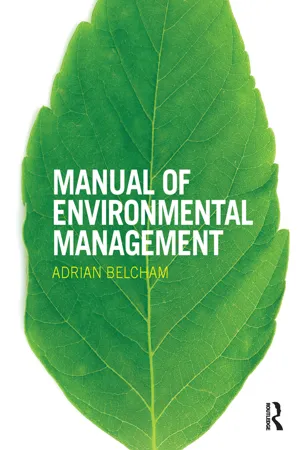
- 354 pages
- English
- ePUB (mobile friendly)
- Available on iOS & Android
Manual of Environmental Management
About This Book
Manual of Environmental Management is a practical guide for those involved in the control and reduction of environmental impacts in organisations. This comprehensive and practical guide takes you through the main environmental challenges organisations face and the improvement strategies used to manage them.
Chapter by chapter, Manual of Environmental Management discusses the fundamental issues and principles surrounding environmental policy, law and management and provides crucial information on how to respond and implement environmental programmes.
This book is the perfect reference tool for the environmental professional and an invaluable study text for those preparing for professional examinations such as the NEBOSH Environmental Diploma and IEMA Associate Membership Exam.
Frequently asked questions
Information
Chapter 1 Understanding environmental and sustainability principles
- ENVIRONMENTAL PROCESSES AND PRINCIPLES
- What do we mean by the term ‘environment’?
- Ways of describing the environment
- Categories of environmental impacts
- The process of pollution: the source-pathway-receptor model
- Resource depletion
- Natural cycles and systems
- The importance of linkages
- The hydrological cycle
- The food chain/energy cycle
- The carbon cycle
- The nitrogen cycle
- The phosphorus cycle
- Activities, aspects and impacts
- Definitions and descriptions
- An aspects checklist
- Environmental receptor groups
- What do we mean by the term ‘environment’?
- AN OVERVIEW OF KEY ENVIRONMENTAL PROBLEMS
- Air quality
- Key atmospheric pollutants
- Climate change
- Ozone depletion
- Acid rain
- Photochemical smog
- Water quality and availability
- Pollutant categories
- Groundwater pollution
- Freshwater availability
- Management of natural resources
- Population growth
- Energy
- Land contamination
- Availability of productive land
- Biodiversity and ecological stability
- Chemicals exposure
- Waste
- Human community issues
- Nuisance
- Infrastructure/amenity impacts
- Cultural heritage impacts
- Air quality
- THE PLACE OF HUMAN BEINGS IN THE ‘ENVIRONMENT’
- Sustainability and sustainable development
- Ecosystem products and services
- The international commitment to sustainable development
- The Earth Summit, 1992
- The Earth Summit II, 1997
- Rio+10, 2002
- Rio+20, 2012
- Sustainable development: an economic, social and environmental goal
- Relative sustainability
- Absolute sustainability
- FURTHER RESOURCES
I ENVIRONMENTAL PROCESSES AND PRINCIPLES
Many people with influence and wealth treat the earth as something to be owned.To be used and abused to suit their own ends.But the earth is a living being, a great spiritual source.To disregard this source is to call forth catastrophe, since all creatures great and small are an inherent and interdependent part of this very being.(Inspired by Verse 29, We are the World, trans. R. A. Dale, 2002)
1.1 What do we mean by the term ‘environment’?
1.1.1 Ways of describing the environment

1.1.2 Categories of environmental impacts
- ► pollution;
- ► resource depletion.
- ► Pollution – the introduction by man of substances or energy into the environment that are liable to cause hazards to human health, harm to ecological systems, damage to structures or amenity, or interference with legitimate uses of the environment.
- ► Resource depletion – the consumption of natural resources that are either finite in their existence (non-renewable resources) or are managed in such a way as to permanently deplete potentially renewable biological or physical resources. Examples of non-renewable resources include fossil fuels and mineral ores. Examples of resources which may be indefinitely renewed if managed/consumed appropriately include fish stocks and timber.
1.1.3 The process of pollution: the source-pathway-receptor model
| Acute pollution impacts | Chronic pollution impacts |
|---|---|
| Follow fairly immediately aft... |
Table of contents
- Cover
- Half Title Page
- Title Page
- Copyright Page
- Dedication
- Table of Contents
- List of figures
- List of tables
- Preface
- Acknowledgements
- 1 Understanding environmental and sustainability principles
- 2 Environmental policy
- 3 Environmental law
- 4 Understanding environmental management and sustainable development in a business context
- 5 Collecting, analysing and reporting on environmental information and data
- 6 Environmental management and assessment tools
- 7 Analysing problems and opportunities to deliver sustainable solutions
- 8 Developing and implementing programmes to deliver environmental performance improvement
- 9 Communicating effectively with internal and external stakeholders
- 10 Influencing behaviour and implementing change to improve sustainability
- Glossary
- Bibliography
- Index